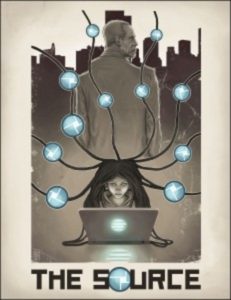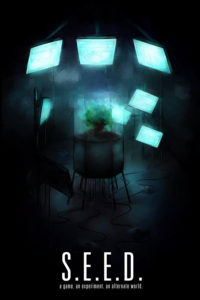Down the Rabbit Hole: Social Technology Tools in Educational Alternate Reality Games
“If children can build, play and understand games that work, it’s possible that someday they will understand and design systems that work. And the world is full of complicated systems.”
— Sara Corbett, Journalist, New York Times
As part of our Social Media in Education course for our Master of Teaching programme at the Ontario Institute of Studies in Education (University of Toronto), I investigated a critical question of my choosing. In general, I am very interested in Game Based Learning – specifically, educational Alternate Reality Games (ARGs). One reason aligns with Corbett’s quote above. I first came across this narrative form as a producer for an interactive Daily Planet segment for Discovery Channel here in Canada.
ARGs are interactive, networked narratives (dubbed storyscapes by Blumenthal, 2012). At their core, they behave like complex scavenger hunts. They rely on existing real-world environments as their game space and employ transmedia storytelling, often both online and offline, to deliver content that may be altered by students’ ideas or actions. They can be considered “games you play in order to get more out of real life, as opposed to games you play to escape it” (McGonigal, 2011, Chore Wars, para. 30). Such ARGs have the potential to provide learning environments that help foster competencies and extend education to where learners are not only consumers of knowledge, but producers of it as well. This makes ARGs ripe with potential for educational applications.
A step away from the passivity that learners may associate with the traditional classroom, the dynamic nature of Serious ARGs can motivate players by giving them a focused problem to solve. The solution process elicits knowledge and learning rewards, while goal-driven environments morph player game play into a focused, engaged learning experience (Lynch, Mallon, Connolly, 2015, p. 35).
Yet, ARGs are a relatively unfamiliar concept, particularly in the realm of education. Patrick Jagoda, PhD, Associate Professor of English at the University of Chicago, and Game Designer and Project Manager Ashlyn Sparrow do a great job giving a bit more background in the video below. Jagoda is also a researcher behind one of the articles and ARGs I analyzed (The Source).
To help demonstrate what a serious ARG looks like in practice, here is a trailer for the ARG Urgent EVOKE, by game designer and author, Jane McGonigal (cited above).
ARGs can be used as instructional tools in any subject (often with a cross-curricular lean), and as part of media pedagogies; they can be used to teach History, STEM subjects, literacy and any combination beyond and therein. They often challenge students to problem-solve and to employ other 21-century competencies (such as collaboration).
As there appears to be a research gap with educational ARGs in general, and in the way social technologies are best utilized within ARGs specifically, I created an annotated bibliography that reviews articles with a more a general focus on ARGs. Within these articles, I then considered how social technologies are leveraged in each case.
This Annotated Bibliography helped inform and illuminate a response to my critical inquiry:
“How can social technologies successfully be integrated into Alternate Reality Games intended as instructional tools in the classroom?”
ARGs as Environments of Possibility
What I discovered is that ARGs are as varied as the people who design them and the circumstances that give them rise. “It is difficult to make generalizations of what an ARG is or looks like for learning….Designs could range from something very simple (e.g. a scavenger hunt) to something very complex (e.g. large scale problem-based learning experience)” (Olbrish, 2011, p 2). They serve as custom, scalable sandbox environments that can be tailored to specific groups of students and their learning objectives. By extension, social technologies (which encompass social media and other social software), are tools often leveraged by ARGs, and vary in their application case-by-case, both in extent of their integration, as well as applied function. Nevertheless, all the articles I examined used Social Technologies, at least to some extent in their ARGs. As one author found, this is because
a range of ICT and Web2.0 technologies…are freely available and therefore feasible and secure for schools to use. This is important because the overall feasibility of integrating ARG with teaching science or other disciplines rests on the ability of schools to access secure, easy-to-use technology that incurs no financial expense….one of the advantage of ARG over other forms of gaming is that it relies on the use of free or low cost software for mediating the online interactions (Bellocchi, 2012, p. 46).
Social Technologies used included wikis, blogs (edublogs, WordPress, etc.), free websites (such as wix), YouTube (using short video, vlog and webisode form), NING, Facebook, Twitter (using promotional tweets, character tweets, as well as “twitter novels”), Blackboard, online forums such as Unforum, a fake Kickstarter campaign, Google search, Google Docs, Wikipedia, QR code technology, Augmented Reality technology, email, Prezi and / or PowerPoint.
Nevertheless, as Boskic reminds, “[w]e have to avoid the lure of bleeding-edge technologies without solid pedagogy behind it” (2011, p. 680). The best examples of social technology uses in ARGs approached such integration with deliberate purpose and explicit learning objectives that included technological literacy (Jagoda, 2015, p. 93).
Social Technologies as ARG Marketing Tools vs. ARG Narrative
Some of the examples I explored leveraged social technologies such as Twitter and Facebook to raise awareness of ARGs (particularly at the University Level), while some leveraged these and platforms such as wikis, blogs and YouTube to convey the ARG’s narrative to participants (particularly at middle school or high school levels, or smaller class environments, where participation was part of class curriculum and no added awareness needed to be raised). Some also sought to do both (not always successfully, as Whitton acknowledges).
Using Social Technologies to Co-Create ARG Artefacts
By employing different media, designers created a distributed narrative that was reflexive, and changed as it responded to player contributions. Social Technologies, and specifically social media, offered ARG designers (often teachers or professors) with opportunities to engage with participants in real time and to customize the experience for some of them (Jagoda, 2015, p. 81) – perhaps another take on enabling differentiated instruction.
In such narratives, fact and fiction frequently merged, as participants added their own solutions, narratives, and understandings to fictional storyscapes. Here, participants were also co-constructors of knowledge. The process was beneficial for several reasons: “Social media effectively enabled students to become more autonomous and develop metacognition” (Greenhow & Lewin, 2016, p. 18). Additionally, social media enabled participants to harness collective intelligence via the network and to seek out relevant expertise (Greenhow & Lewin, 2016, p. 23) – a transferrable skill that may benefit students in future learning.
Social Technologies as Potential for Change
Some of the most interesting examples in social technology integration leveraged such technology for social change, employing Youth Participatory Action Research frameworks, extending social justice initiatives, and engaging in socio-scientific issues, and more. Some participants in Jagoda’s study even leveraged this literacy further to pursue civic and socio-political activities (Jagoda, 2015, p. 93) and acquired real-world credentials. They earned digital badges that showcased their newly-acquired skills.
These badges could appear on their individual profiles, which could be accessed via the games central website. Most interestingly, the game designers treated these badges not just as extrinsic motivators in game-play, but as legitimate credentials that were linked to larger citywide summer education efforts, with the intent to link participants to future real-world academic opportunities, internships, and career paths. “The Source made available badges for web designer (website creation and layout), caster (podcasting and sound design), media socialite (social media ethics), blogger (news writing and interviewing for blogs) and documenter (visual-media production)” (Jagoda, 2015, p. 87).
The initiative was so successful, Jagoda and colleagues continued their initiative, extending it through another ARG iteration, called S.E.E.D.
For Educators Designing ARGs:
Chess & Booth make several suggestions for educators looking to create their own educational ARGs. Among them:
Make interactive and image-based visualizations of class ARGs when introducing this narrative form to students. A simple linear outline cannot fully encompass the multiple structures and varied pathways an ARG can take. If you are going to have students rewrite your ARG or playtest their own in class, offer a fully interactive visualization of the game – either through Prezi, through a wiki, or even through a PowerPoint. This provides students with a better understanding of the forking-paths and possibilities of ARG gameplay (Chess & Booth, 2014, p. 1015).
RESOURCES:
- http://www.argology.org/args-in-education-training/
- https://www.argn.com
- http://www.unfiction.com
- https://www.reddit.com/r/ARG/new/
Trailblazing ARGs (commercial as well as serious or educational ARGs):
- The Beast (arguably the first ARG, designed in 2001)
- I. Artificial Intelligence
- Aftershock
- I Love Bees
- Conspiracy For Good
- World Without Oil
- The Source
- The Ghost Scoryscape
- Urgent Evoke
- Superstruct
- The Tower of Babel
- Traces of Hope
- Ghosts of a Chance
- Humans vs. Zombies
REFERENCES:
Bellocchi, R. (2012). Practical Considerations for Integrating Alternate Reality Gaming Into Science Education. Teaching Science, 58(4), 43-46.
Blumenthal, H., & Xu, Y. (2012). The ghost club storyscape: Designing for transmedia storytelling. IEEE Transactions on Consumer Electronics, 58(2), 190-196. doi:10.1109/TCE.2012.6227412
Blumenthal, H. (2016). Storyscape, A New Medium of Media: A Dissertation. 232-239. Retrieved from https://smartech.gatech.edu/handle/1853/54989
Boskic, Natasha. (2011). Play to become a leader and a citizen of the world: ARGs as teaching spaces for personal and social change. European Conference on Games Based Learning, 675.
Chess, S., & Booth, P. (2014). Lessons down a rabbit hole: Alternate reality gaming in the classroom. New Media & Society, 16(6), 1002-1017. doi:10.1177/1461444813497554
Garcia, A. (2012). “Inform, Perform, Transform. Participatory Culture and Learning, 41(1), 46-50.
Jagoda, P., Gilliam, M., McDonald, P., & Russell, C. (2015). Worlding through play: Alternate reality games, large-scale learning, and the source. American Journal of Play, 8, 74+. Retrieved from http://go.galegroup.com.myaccess.library.utoronto.ca/ps/i.do?p=AONE&sw=w&u=utoronto_main&v=2.1&it=r&id=GALE%7CA435191272&asid=07ecbbe9a202df9bbc096193a6d8aea8
Johnson, M., Buhler, A. G., & Hillman, C. (2010). The library is undead: Information seeking during the zombie apocalypse. Journal of Library Innovation, 1(2), 29-43. Retrieved from http://myaccess.library.utoronto.ca/login?url=http://search.proquest.com/docview/865643923?accountid=14771
Lynch, R., Mallon, B., & Connolly, C. (2015). The pedagogical application of alternate
reality games: Using game-based learning to revisit history. International Journal of Game-Based Learning, 5 Retrieved from http://go.galegroup.com.myaccess.library.utoronto.ca/ps/i.do?p=AONE&sw=w&u=utoronto_main&v=2.1&it=r&id=GALE%7CA429883269&asid=2c24aac539f5a1749762b5a080a224c9
McGonigal, J. (2011) Reality is Broken: Why Games Make Us Better and How They Can Change the World [Kindle Cloud Reader version]. Retrieved December 22, 2016 from https://www.amazon.ca
Olbrish, K. (2011). The ABC’s of ARGs: Alternate reality games for learning. Elearn, 2011(8) doi:10.1145/2016016.2019544
Whitton, N. (2011). Encouraging engagement in game-based learning. International Journal of Game-Based Learning, 1 Retrieved from http://go.galegroup.com.myaccess.library.utoronto.ca/ps/i.do?p=AONE&sw=w&u=utoronto_main&v=2.1&it=r&id=GALE%7CA429812327&asid=4d64f39029344cb0721a32b94547b555


